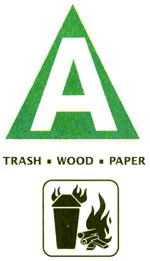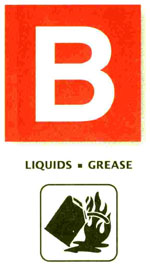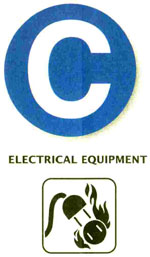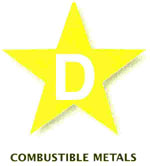It is important to keep a fire extinguisher on hand at all times, but equally important to know which type of extinguisher to have and how to use it.
Fire Extinguisher Classifications
Fire extinguishers are categorized into four classes which are determined by the type of fuel burning.
Type A
A extinguishers fight ordinary combustibles such as burning wood, cloth, paper, rubber, upholstery, and plastics.
 Type B
Type B
B extinguishers fight flammable liquids, gases and greases such as oils, paints, and gasoline.
 Type C
Type C
C extinguishers fight energized electrical fires such as burning wires, fuse boxes, circuit breakers, machinery, and appliances.
 Type D
Type D
D extinguishers are used on fires caused by combustible metals such as magnesium, sodium, potassium, and aluminum.
How to Use your Fire Extinguisher
To use a fire extinguisher, use the PASS technique: Pull, Aim, Squeeze, and Sweep.
 Pull
Pull
Pull the safety pin at the top of the extinguisher. Some units have latches or levers instead.
 Aim
Aim
Aim the nozzle, horn, or hose at the base of the flames. Hold the extinguisher vertically to ensure the unit will have enough pressure.
 Squeeze
Squeeze
Squeeze or press the handle to release the extinguisher agent. Always read manufacturer's directions for your particular model.
 Sweep
Sweep
Sweep from side to side at the base of the fire and at least six inches past the edges of the flames until completely extinguished.
When you see smoke or fire
- Exit the building
- Do not fight the fire unless you have received training in the safe use of fire extinguishers
If you have received training:
- Use good judgement
- Communicate to others about the fire and what you are doing
- Use the extinguisher
- Get out immediately if something goes wrong
Fire Extinguisher Tips
What's Your Type
A fire extinguisher is your best defense against small, contained fire that have just begun to burn. Extinguishers can control flames until the fire department arrives, and buy you enough time to get out of a burning structure.
Every type of extinguisher is designed to fight a certain class or classes of fire. There are four classes which are determined by the type of fuel. Learning to identify these classes will help you select the right fire extinguisher. Using the wrong type of fire extinguisher can cause a fire to spread and place you in great danger.
Close to a Location Near You
Extinguishers should be installed close to high-traffic areas, near exits and hazards, and on wall brackets no higher than five feet from the floor.
It's About Time
Acting fast can make the difference between a small fire and one that consumes your whole building. Before fighting a fire, be certain that everyone has been alerted to the fire and is leaving the building, and that the fire department has been called. Fight the fire only if the fire is small and contained, a correct type of extinguisher is within easy reach, and you are near a clear exit in case you need to escape.
Ready for Inspection
Service rechargeable units and replace disposable models immediately after each use. Check pressure gauges and carbon dioxide containers monthly. Inspect all containers on a regular basis looking for damage, corrosion or tampering. Make sure extinguishers are easy to remove from hooks or wall brackets.
Maintain inspection records of usage and service. Records are helpful after a fire to prove to insurance companies that extinguishers were all serviced and in working order.
